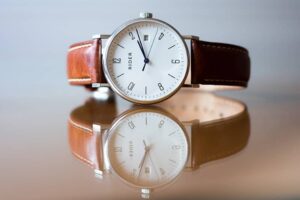How to Determine Which Watch Crystal You Have
You may have heard of a watch crystal. If you’re not familiar with watches, you might assume this is some kind of fancy crystal or precious stone inlaid in the watch. If you’re an avid watch collector, you’ll know that the crystal is simply the clear part of the watch that goes over the face.
But did you know that watch crystals are made from different materials? And do you know how to determine which kind of crystal is on your watch?

What Is a Watch Crystal?
The watch crystal does more than provide a clear covering—it acts as protection for the watch from dirt, moisture, and contact damage.
Surprisingly, watch crystals did not exist until the 1600s. The earliest clocks had completely exposed faces. A hinged metal cover was then invented, which could be opened to see the time and closed to protect the clock or pocket watch. Eventually, a kind of quartz called rock crystal came into watchmaking fashion as a way to protect the face of the watch—hence the term “watch crystal.”
In the 1800s, watchmakers began to incorporate mineral glass into watch crystals. The 1930s then saw the introduction of two new watch crystal materials: acrylic and sapphire. Today, these are the three materials that are still used to make watch crystals.
Acrylic Crystals
Acrylic crystals are made from lightweight but strong plastic. They are the least expensive kind of watch crystal and, unfortunately, the most prone to scratches. However, they’re strong enough that they won’t easily shatter.
Acrylic watch crystals are highly reflective, which sometimes makes it difficult to tell the time. But their affordable price and shatter-resistant qualities make them popular in cheap watches as well as children’s watches. You will often find acrylic crystals in vintage watches, too, because they were very widely used from their inception until the 1980s or so.
Mineral Glass Crystals
Mineral glass crystals are the most common crystal type on the market today. They’re the middling material—they are more expensive than acrylic crystals but cheaper than sapphire. Likewise, they’re more prone to scratching than sapphire crystals but less so than acrylic. They are also less reflective than acrylic but more reflective than sapphire.
These crystals are heat-treated and coated with a hardening material to improve their hardness. Still, they are the most likely of the three materials to shatter, especially in extreme temperatures.
Sapphire Crystals
Sapphire crystals are the premium material. They’re the least reflective and most durable and scratch-resistant of the three types of crystals—but they’re also the most expensive. Sapphire is the second-hardest material in the world (right behind diamond). All these qualities make sapphire the most valuable type of watch crystal.
Most sapphire crystals are synthetic, though natural sapphire watch crystals do exist. These crystals can be found in either a flat or domed shape, with the latter being found more often in vintage watches. Regardless of the era, if you own a luxury watch, its crystal is almost certainly made from sapphire.
How to Tell Which Watch Crystal You Have
If you’re unsure which type of watch crystal you have, you can always try scratching it with a knife to figure it out. However, unless you’re ready to pay for a watch repair service, this is obviously not something we’d recommend. Instead, you can employ a few tests to narrow it down.
The Temperature Test
The temperature test will tell you whether or not you have an acrylic watch crystal. Simply hold the crystal against your cheek. If it feels warm, your crystal is acrylic. If it’s cold, you can move on to the next test to determine whether you have a mineral glass or sapphire crystal.
The Tapping Test
This test will tell you whether your crystal is made from mineral glass or sapphire. Tap on the crystal with your fingernail while holding the watch close to your ear. If it makes a solid, low-toned sound, your crystal is sapphire. If you instead hear a higher-toned sound, you have mineral glass.
This test can sometimes make it hard to definitively tell which material you have, especially if you’re not sure what each material sounds like. If you’re having trouble differentiating between sounds, you can try the water droplet test.
The Water Droplet Test
To see whether you have a mineral glass or sapphire crystal, try dropping a little water on it and slightly tilting the watch. If the water droplet flows and leaves tiny drops behind, you have a mineral glass crystal. If the water droplet holds its shape, congratulations—you have a coveted sapphire crystal!
The Foolproof Test
If all else fails, you can always bring your watch to a watch repair shop and ask them to determine which crystal material you have. An experienced watch repair specialist will be able to tell you the answer without damaging your watch. Additionally, if you’re interested in swapping out one crystal material for another, a skilled watchmaker can find the perfect crystal to customize your watch.

